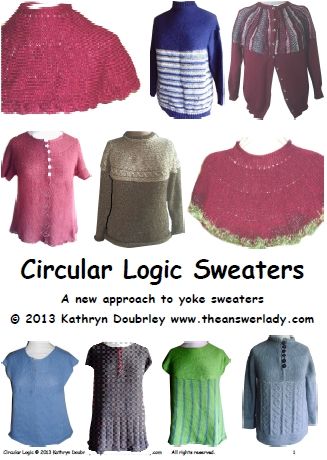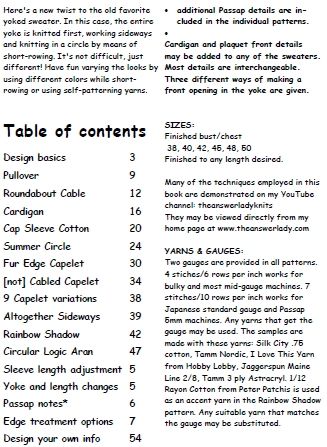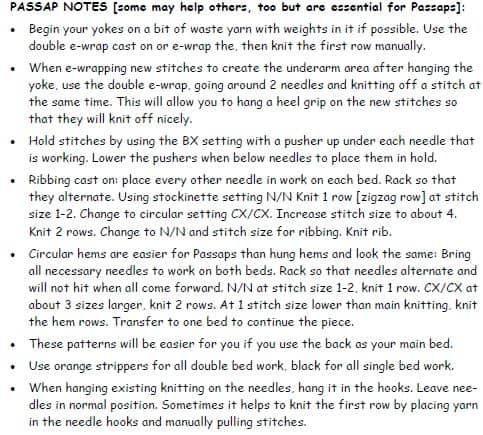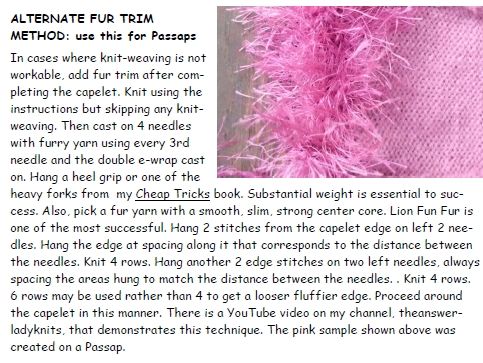| All sales are final......books are pdf files delivered via Ravlery. You need not be a Ravelry member to download. |

|
 |
 |
Duomatic terms are used. These sweaters are entirely do-able on E-6000 machines but the technique numbers are not included simply because I am a Duomatic knitter and not familiar enough with the terms to insure accuracry.
 |
|
Sponge Bar Sorrows © 2017 Kathryn Doubrley Www.theanswerlady.com This sponge bar article is on the Circular Logic page for a logical reason! the beginnings of sponge bar failure rarely show up in plain stockinette. It's when we start to do something a little more such as fairisle, tuck or short rowing that issues begin to arise and they can be unpredictable. Circular Logic sweaters involve short rowed yokes to make the circles so you'll want to attend to the condition of your sponge bar when knitting these designs. If a machine utilizes a sponge bar, it's essential equipment. The function of the sponge bar is to press the needles down. Inside the bed, where we can't see, there is a comb spring pressing the needles up. the tension between these two forces keeps the needles positioned to performa optimally. Some European made machines such as Passaps, Superbas and Orions use a spring to do more or less the same job. While the spring is a wear item, it lasts a lot longer than a sponge bar. a sponge bar may wear gradually or may seem to fail very suddenly. What happens when a sponge bar stops working? The short answer is "mayhem." In greater detail, absolutely everything may start to go wrong, including but not limited to: occasional mis-patterning, failure of a cast on that should work fine, disastrous mis-patterning, failure to knit off some stitches randomly, total failure of fairisle and eventually terrible carriage jams. So, clearly, keeping the sponge bar in good shape is something every knitter wants to do. Sometimes, the machine continues to work fairly well in stockinette or work with extra weight but misbehave when under any challenge such as tuck stitch or fuzzy yarn. A sponge bar that looks okay may or may not be. It should be puffy and bouncy with the sponge part extending well above the metal part. I'll call the metal part a tray because that's what it really is. It's a long skinny tray that holds the sponge. I have had "new" sponge bars that looked absolutely fine fail to function when inserted in the machine. Close examination showed that these had been stored for a long time. Though they were un-used, the foam had lost its bounce. This isn't a really common problem but is something to look for if your troubles continue after changing a bar. They don't last forever in storage. My old/new bars were part of an estate find. I'm sure that's how un-used bars got so old. Some experienced knitters recommend removing the sponge bar from the machine when the machine is not in use. The reason for this is that the sponge remains compressed while in the machine but relaxes when it is removed. Allowing it to relax may extend its life. I don't personally do this but I knit constantly so the machines are hardly ever not in use. I do see the sense of the advice. Original equipment manufactured sponge bars have become both expensive and sometimes hard to find. Some brands are simply unavailable. Recently, we have been hearing from a lot of customers who had trouble with brand new sponge bars. I've done a good deal of research and bought some after market bars myself and here is what I think is happening. Inexpensive copies that are a pretty good fit for the machines are being made in China. Some of these my be fine but the ones I have bought were not good performers. Some of them just didn't do the job well and others rusted almost immediately. Customers have told us of bars that didn't fit properly, too. My sense of the matter is that those manufacturing the bars don't have enough knowledge of their function to produce exactly what we need. So at this point, we are recommending spending the extra money for original equipment from a dealer or re-building your old bar. Re-building is actually quite simple. It involves a careful cleaning of the tray and replacing the old, worn sponge with fresh sponge. I have a video on the subject. But re-building has its hazards. The first thing to beware of is the sponge itself. I personally use only sponge from spongebar.com It has been satisfactory every time. I use the self-adhesive kind and the adhesive is good. But this product is not cheap and similar looking sponge is available at much lower prices from ebay sellers. I don't recommend it unless you are very experienced. The reason is that an experienced knitter will know right away if the sponge is or is not working well. She can afford to risk a few dollars |
